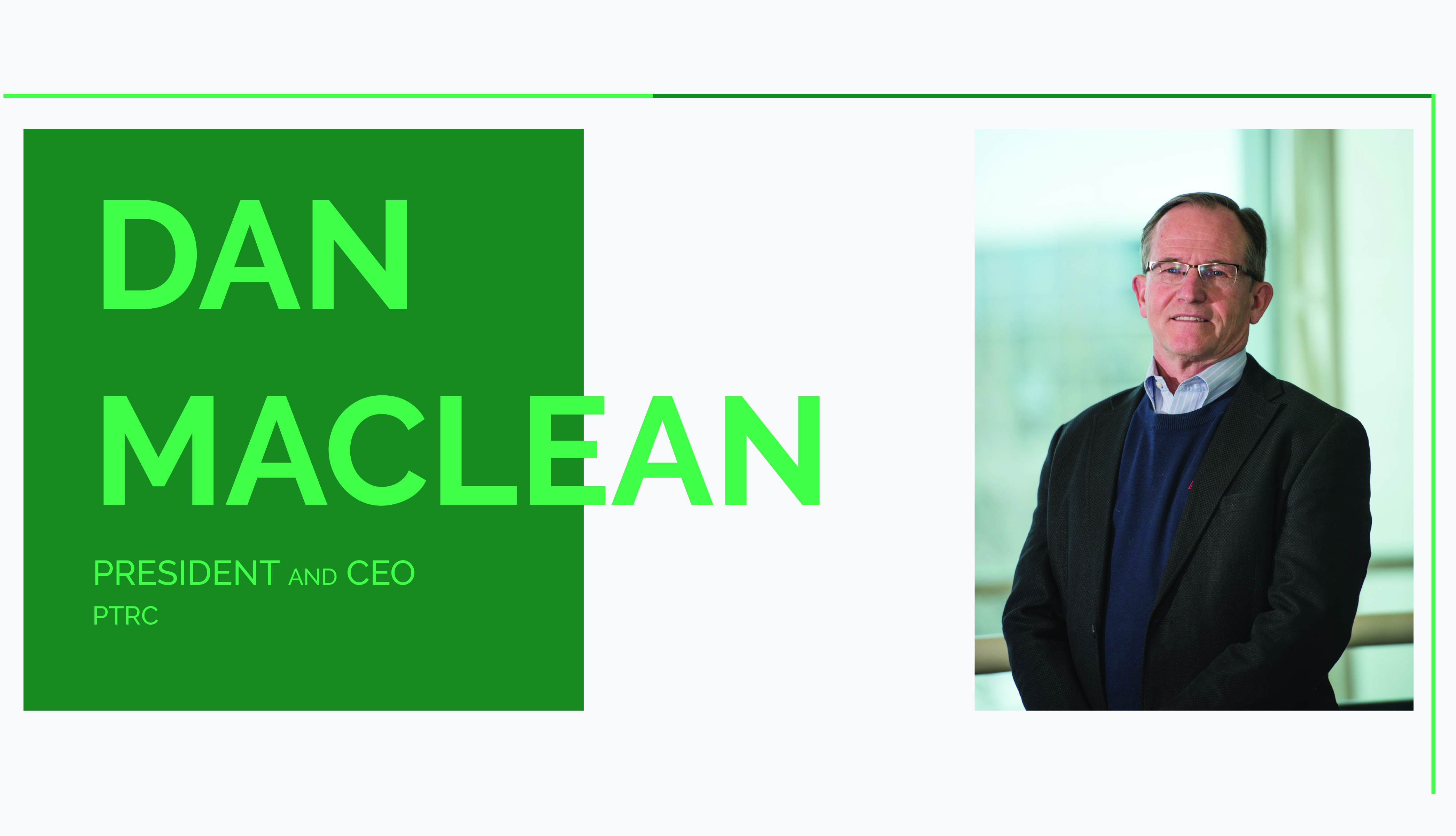PTRC has had another year of building on a legacy of high quality research with direct impact on GHG emissions reduction and sustainable resource production. I will limit my year end comments to three areas of research (HORNET, Tight/light Oil and CO2 storage) and our communication/outreach efforts for 2021.
Heavy Oil Research Network (HORNET)
Our 2020 HORNET program was delayed due to COVID but got started near the end of 2020, and was in full swing in 2021. The 2021/22 program was approved by April with 12 projects defined by our industry sponsors – Cenovus and CNRL – totaling over $1.2MM. Nearly $500K in matching MITACS funding for our University partners was also identified for a total program cost of $1.7MM.

The 2021 program is in full operation as folks from U of R and SRC are back working in their labs. Two TAG meetings were held in 2021, both” virtual” over Zoom, and very well attended. Each TAG meeting includes a short planning session to ensure the HORNET program continues to meet the needs of our industry partners. In early 2021, Husky was replaced by Cenovus as a program funder, a company PTRC had a long relationship with at Weyburn. We are pleased that Cenovus and CNRL will both continue to support HORNET.
The focus of the HORNET program is twofold: (1) To identify and test ways to improve the sustainability of a very low recovery resource (4 to 8% recovery of OOIP) from CHOPS wells (Cold Heavy Oil Production with Sand) and (2) Reduce the environmental impact of the products produced through GHG emissions reductions, and better use of existing infrastructure through delaying well abandonments.
Tight/Light Oil Research
The 2021 program for Tight/Light Oil included two AI/Machine Learning projects, one by SRC and one by the U of R. We are very pleased to see both organizations building this expertise to take advantage of the huge wealth of data generated by the resource industry. The end game is to develop prediction tools required by industry that are better, cheaper, and faster to make “risk managed” and informed business/capital decisions. Two webinars in 2021 featured the research from both projects, and are available at the PTRC’s YouTube page.
Click on each image to view our separate webinars on Machine Learning and Oil & Gas.
PTRC worked with a third party reserve evaluator to characterize the potential for other CO2 EOR projects in SE Saskatchewan. The study was funded by SaskPower, the provider of carbon dioxide to the Weyburn CO2 EOR project, and the source for PTRC’s Aquistore deep saline storage project. The study was completed and a final report delivered to SaskPower in October.
Aquistore
Speaking of Aquistore, 2021 was another year of significant research activity for the world’s only research facility dedicated to CO2 storage in a deep saline geologic formation (3.2 km underground) and corresponding measurement, monitoring and verification (MMV). PTRC researchers from the U of Alberta completed a reservoir simulation model of CO2 production from Aquistore’s observation well. The purpose was to theoretically demonstrate that CO2 could be reproduced at the observation well without producing a lot of water. This was a first step in understanding the potential to produce CO2 for the purposes of extracting heat for use in geothermal-based electricity. The study was funded by the Swiss Ministry of Energy with support from ETH Zurich.
A “3rd Well Roadmap” project, funded by SaskPower, was competed in 2021 and provided 6 potential locations for a new injection well for the Boundary Dam CO2 capture facility, along with a roadmap for licensing, drilling, and completing the well. An MMV plan for CO2 injection with the new well was also provided.

Dr. Alireza Rangriz Shokri of the University of Alberta completed a reservoir simulation model at Aquistore with geothermal energy implications
Aquistore researchers from the EERC (Energy Environment Research Center located at the U of North Dakota) completed a new reservoir simulation model of Aquistore designed to identify and forecast injection capability for a range of potential new well locations in Aquistore.
In December, PTRC researchers from the Geological Survey at Natural Resources Canada (NRCan) provided funding for a “Crosswell Seismic” program between the injector and observation well. In preparation for the seismic program the observation well underwent a remedial workover to remove an obstruction. The Crosswell survey was completed on December 16th and data is currently being reviewed.

PTRC’s Zeinab Movahedzadeh (foreground), Don White of the Geologic Survey of Canada (left) and PTRC’s Erik Nickel at the Aquistore site, working on the Crosswell survey in December, 2021
Communications and Outreach
Our 2021 communications plan included postings and publications to a number of platforms and outlets, from social media posts on LinkedIn, Facebook, and Twitter, to regular updates to our website including adding a permanent webcam at Aquistore. We also hosted 5 webinars in 2021, and had multiple featured articles in trade publications.
The Williston Basin Petroleum Conference was held in Bismarck ND in May. The PTRC participated virtually and was featured in a sponsored event. As I write this, the PTRC is preparing to host the next WBPC in Regina in May of 2022.
Bismarck ND in May. The PTRC participated virtually and was featured in a sponsored event. As I write this, the PTRC is preparing to host the next WBPC in Regina in May of 2022.
On a personal note, earlier in the year I announced my retirement from PTRC effective December 31, 2021. I have had the remarkable pleasure to lead PTRC for the past 5 years. I am eternally grateful to the staff for their support and commitment to what PTRC does and stands for in Saskatchewan. My thanks go to Innovation Saskatchewan, the Province of Saskatchewan, the PTRC Board of Directors, SaskPower and our industry sponsors (CNRL, Cenovus, ANLEC, Mosaic, SaskPower) who have helped guide and fund the PTRC.
I would like to thank the researchers who do the work that defines what the PTRC is in HORNET, Tight/Light Oil, and Aquistore. They include but are not limited to the U of R Petroleum Systems Engineering, Geology, and Computing Science Departments, the U of S’s Engineering and Geology Departments, The Saskatchewan Research Council (SRC), U of A, and the EERC in North Dakota just to name a few . Finally, I would like to acknowledge the alliances the PTRC has forged and nurtured over the years with folks and organizations from Saskatchewan and Alberta, including our principal funder Innovation Saskatchewan, the Saskatchewan Ministry of Energy and Resources, SRC, the Saskatchewan Geologic Survey, Carbon Management Canada, the International CCS Knowledge Centre, The Johnson-Shoyama School of Public Policy, PTAC, the Clean Resource Innovation Network (CRIN) and others.
For 23 years, since 1998, the PTRC has been ahead of the curve in supporting research in CCS (Carbon Capture and Storage) and CCUS (Carbon Capture Utilization and Storage) with emphasis on CO2 storage, and enhanced oil recovery. In that time, the PTRC has become a leader, managing the best research in the world. I am excited to see what the next 23 years brings for this important organization.
All the best.
Dan MacLean





